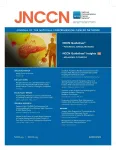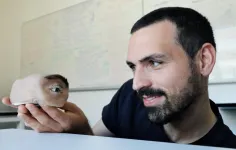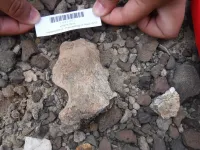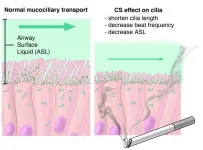Researchers streamline molecular assembly line to design, test drug compounds
2021-04-13
(Press-News.org) Researchers from North Carolina State University have found a way to fine-tune the molecular assembly line that creates antibiotics via engineered biosynthesis. The work could allow scientists to improve existing antibiotics as well as design new drug candidates quickly and efficiently.
Bacteria - such as E. coli - harness biosynthesis to create molecules that are difficult to make artificially.
"We already use bacteria to make a number of drugs for us," says Edward Kalkreuter, former graduate student at NC State and lead author of a paper describing the research. "But we also want to make alterations to these compounds; for example, there's a lot of drug resistance to erythromycin. Being able to make molecules with similar activity but improved efficacy against resistance is the general goal."
Picture an automobile assembly line: each stop along the line features a robot that chooses a particular piece of the car and adds it to the whole. Now substitute erythromycin for the car, and an acyltransferase (AT) - an enzyme - as the robot at the stations along the assembly line. Each AT "robot" will select a chemical block, or extender unit, to add to the molecule. At each station the AT robot has 430 amino acids, or residues, which help it select which extender unit to add.
"Different types of extender units impact the activity of the molecule," says Gavin Williams, professor of chemistry, LORD Corporation Distinguished Scholar at NC State and corresponding author of the research. "Identifying the residues that affect extender unit selection is one way to create molecules with the activity we want."
The team used molecular dynamic simulations to examine AT residues and identified 10 residues that significantly affect extender unit selection. They then performed mass spectrometry and in vitro testing on AT enzymes that had these residues changed in order to confirm their activity had also changed. The results supported the computer simulation's predictions.
"These simulations predict what parts of the enzyme we can change by showing how the enzyme moves over time," says Kalkreuter. "Generally, people look at static, nonmoving structures of enzymes. That makes it hard to predict what they do, because enzymes aren't static in nature. Prior to this work, very few residues were thought or known to affect extender unit selection."
Williams adds that manipulating residues allows for much greater precision in reprogramming the biosynthetic assembly line.
"Previously, researchers who wanted to change an antibiotic's structure would simply swap out the entire AT enzyme," Williams says. "That's the equivalent of removing an entire robot from the assembly line. By focusing on the residues, we're merely replacing the fingers on that arm - like reprogramming a workstation rather than removing it. It allows for much greater precision.
"Using these computational simulations to figure out which residues to replace is another tool in the toolbox for researchers who use bacteria to biosynthesize drugs."
INFORMATION:
The work appears in Nature Communications and was supported by the National Institutes of Health (grants GM104258 and GM118101). Kalkreuter is currently at the Scripps Research Institute. Former NC State undergraduate students Kyle Bingham and Aaron Keeler, as well as Andrew Lowell, Jennifer Schmidt, and David Sherman from the University of Michigan, also contributed to the work.
Note to editors: An abstract of the paper follows.
"Computationally-guided exchange of substrate selectivity motifs in a modular polyketide synthase acyltransferase"
DOI: 10.1038/s41467-021-22497-2
Authors: Edward Kalkreuter, Kyle S Bingham, Aaron M Keeler, Gavin Williams, North Carolina State University; Andrew N Lowell, Jennifer J. Schmidt, David H Sherman, University of Michigan
Published: April 13, 2021 in Nature Communications
Abstract:
Polyketides, one of the largest classes of natural products, are often clinically relevant. The ability to engineer polyketide biosynthesis for the production of novel analogues is critically important. Acyltransferases (ATs) of modular polyketide synthases catalyze the installation of malonyl-CoA extenders into polyketide scaffolds. Subsequently, AT domains have been targeted extensively to site-selectively introduce various extenders into polyketides. Yet, a complete inventory of AT residues responsible for substrate selection has not been established, critically limiting the efficiency and scope of AT engineering. Here, molecular dynamics simulations were used to prioritize ~50 mutations in the active site of EryAT6 from erythromycin biosynthesis. Following detailed in vitro studies, 13 mutations across 10 residues were identified to significantly impact extender unit selectivity, including nine residues that were previously unassociated with AT specificity. Unique insights gained from the MD studies and the novel EryAT6 mutations led to identification of two previously unexplored structural motifs within the AT active site. Remarkably, exchanging both motifs in EryAT6 with those from ATs with unusual extender specificities provided chimeric PKS modules with expanded and inverted substrate specificity. Our enhanced understanding of AT substrate selectivity and application of this motif-swapping strategy is expected to advance our ability to engineer PKSs towards designer polyketides.
ELSE PRESS RELEASES FROM THIS DATE:
2021-04-13
University of Maryland School of Medicine (UMSOM) researchers have shown that psilocybin--the active chemical in "magic mushrooms"-- still works its antidepressant-like actions, at least in mice, even when the psychedelic experience is blocked. The new findings suggest that psychedelic drugs work in multiple ways in the brain and it may be possible to deliver the fast-acting antidepressant therapeutic benefit without requiring daylong guided therapy sessions. A version of the drug without, or with less of, the psychedelic effects could loosen restrictions on who could receive the therapy, and lower costs, making the benefits of psilocybin more available to more people in need.
In all clinical ...
2021-04-13
The "three-body problem," the term coined for predicting the motion of three gravitating bodies in space, is essential for understanding a variety of astrophysical processes as well as a large class of mechanical problems, and has occupied some of the world's best physicists, astronomers and mathematicians for over three centuries. Their attempts have led to the discovery of several important fields of science; yet its solution remained a mystery.
At the end of the 17th century, Sir Isaac Newton succeeded in explaining the motion of the planets around the sun through ...
2021-04-13
PLYMOUTH MEETING, PA [April 13, 2021] -- The April 2021 issue of JNCCN--Journal of the National Comprehensive Cancer Network publishes new research from Memorial Sloan Kettering Cancer Center (MSK) and Gustave Roussy Institute, which suggests that baseline brain imaging should be considered in most patients with metastatic kidney cancer. The researchers studied 1,689 patients with metastatic renal cell carcinoma (mRCC) who had been considered for clinical trial participation at either of the two institutions between 2001 and 2019 and had undergone brain imaging in this context, without clinical suspicion for brain involvement. The researchers discovered 4% had asymptomatic brain metastases in this setting. This group was found to have a low median 1-year ...
2021-04-13
ITHACA, N.Y. - We've all seen them: political ads on television that promise doom gloom if Candidate X is elected, and how all your problems will be solved if you choose Candidate Y. And Candidate Y, of course, approves this message.
Beyond attempting to move a large swath of the population to vote one way or another, the seemingly constant bombardment of negativity in the name of our democratic process is anxiety-inducing, researchers have found.
"Many of my friends and family members wind up quite stressed out, for lack of a better word, during each election season," said Jeff Niederdeppe, professor in the Department of Communication in the College of ...
2021-04-13
With 'Eyecam' they now present the prototype of a webcam that not only looks like a human eye, but imitates its movements realistically. "The goal of our project is not to develop a 'better' design for cameras, but to spark a discussion. We want to draw attention to the fact that we are surrounded by sensing devices every day. That raises the question of how that affects us," says Marc Teyssier. In 2020, the French scientist completed his doctorate on the topic of anthropomorphic design in Paris. Now he is a postdoctoral researcher in the Human-Computer Interaction Lab at Saarland University in Germany.
The research team at Saarland Informatics Campus has developed ...
2021-04-13
Human non-alcoholic fatty liver disease (NAFLD) is a little-understood condition that significantly increases the risk of inflammation, fibrosis and liver cancer and ultimately requires liver transplant.
"NAFLD has been difficult to study mainly because we had no good animal model," said corresponding author Dr. Karl-Dimiter Bissig, who was at Baylor during the development of this project and is now at Duke University.
The disease has both genetic and nutritional components, which have been hard to understand in human studies, and murine models ...
2021-04-13
A new study verifies the age and origin of one of the oldest specimens of Homo erectus--a very successful early human who roamed the world for nearly 2 million years. In doing so, the researchers also found two new specimens at the site--likely the earliest pieces of the Homo erectus skeleton yet discovered. Details are published today in the journal Nature Communications.
"Homo erectus is the first hominin that we know about that has a body plan more like our own and seemed to be on its way to being more human-like," said Ashley Hammond, an assistant curator in the American Museum of Natural History's Division of Anthropology and the lead author of the new study. "It had longer lower limbs than upper limbs, a torso ...
2021-04-13
ITHACA, N.Y. - The muon is a tiny particle, but it has the giant potential to upend our understanding of the subatomic world and reveal an undiscovered type of fundamental physics.
That possibility is looking more and more likely, according to the initial results of an international collaboration - hosted by the U.S. Department of Energy's Fermi National Accelerator Laboratory - that involved key contributions by a Cornell team led by Lawrence Gibbons, professor of physics in the College of Arts and Sciences.
The collaboration, which brought together 200 scientists from 35 institutions in seven countries, set out to confirm the findings of a 1998 experiment that startled physicists by indicating that muons' magnetic ...
2021-04-13
In the Cascadia subduction zone, medium and large-sized "intraslab" earthquakes, which take place at greater than crustal depths within the subducting plate, will likely produce only a few detectable aftershocks, according to a new study.
The findings could have implications for forecasting aftershock seismic hazard in the Pacific Northwest, say Joan Gomberg of the U.S. Geological Survey and Paul Bodin of the University of Washington in Seattle, in their paper published in the Bulletin of the Seismological Society of America.
Researchers now calculate aftershock forecasts in the region based in part on data from subduction zones around the world. ...
2021-04-13
In a series of experiments that began with amoebas -- single-celled organisms that extend podlike appendages to move around -- Johns Hopkins Medicine scientists say they have identified a genetic pathway that could be activated to help sweep out mucus from the lungs of people with chronic obstructive pulmonary disease a widespread lung ailment.
"Physician-scientists and fundamental biologists worked together to understand a problem at the root of a major human illness, and the problem, as often happens, relates to the core biology of cells," says Doug Robinson, Ph.D., professor of cell ...
LAST 30 PRESS RELEASES:
[Press-News.org] Researchers streamline molecular assembly line to design, test drug compounds



